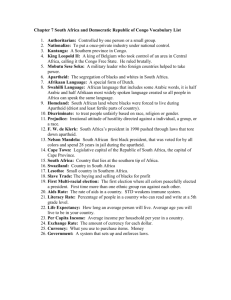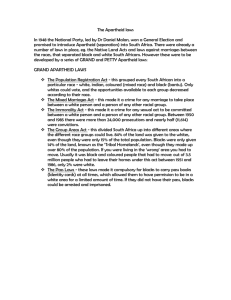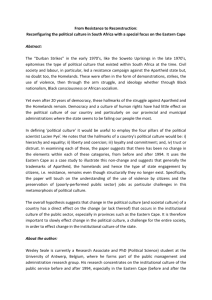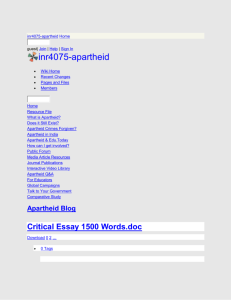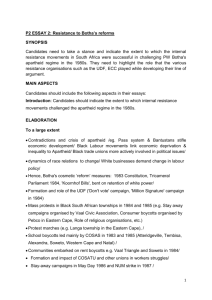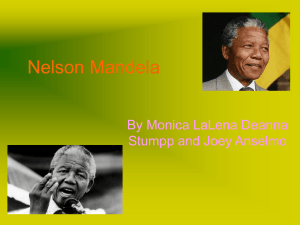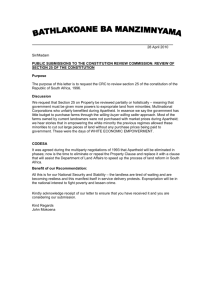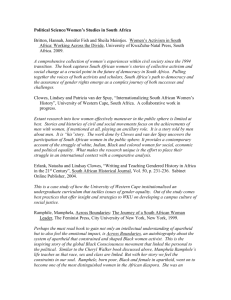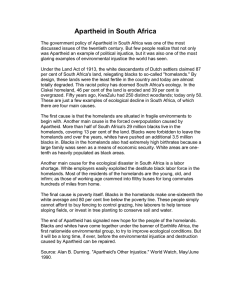Apartheid in South Africa
advertisement
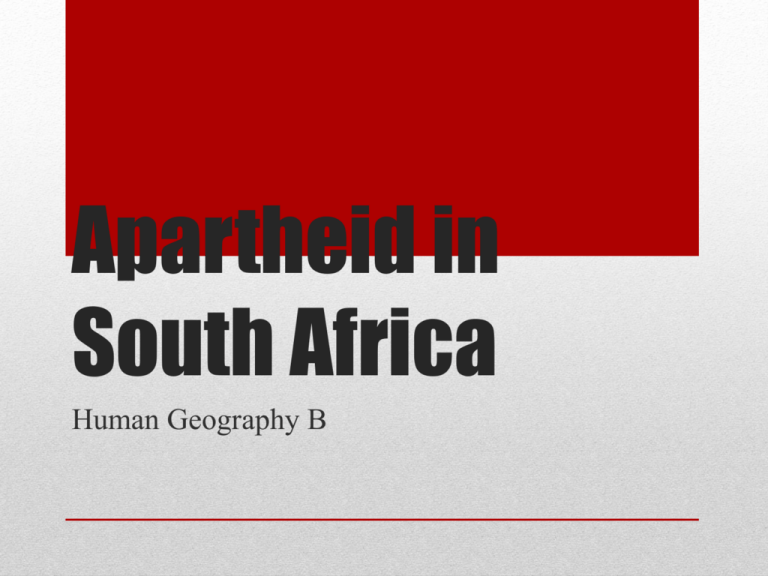
Apartheid in South Africa Human Geography B • Europeans became interested in South Africa because of the route around the Cape of Good Hope, located at the southern-most tip of South Africa. • It was important for global trade and allowed for naval protection. • The Suez Canal did not exist until 1869. Until then, all shipping between Europe and Asia, Australia, and most of Africa had to be done by the long route around South Africa’s Cape. History of South Africa • The Cape was known as the “Cape of Storms” because it was very dangerous for sailing. • In 1652, the Dutch set up a permanent settlement at the Cape of Good Hope to supply passing ships with water and vegetables. • This “supply depot” developed into the Cape Colony over the next two hundred years. The Dutch (the Boers) The Arrival of the Dutch • The British would also fight for control of the Cape Colony starting in 1775, fighting both the Dutch and the Zulu. • In 1910, the Cape Colony, Natal, and two Boer Republics joined together to create the Union of South Africa (Republic of South Africa). The British • Literally means “Apartness” in Afrikaans (Dutch word for African and the language that developed in the Cape Colony). • Racial Segregation in South Africa from 1948-1994. Definition of Apartheid • The first use of the word “Apartheid” came in a speech in 1917 by Jan Christaan Smuts who would later become Prime Minister of South Africa. • However, Apartheid can be traced back to the colonization by the British. • During this time, non-Whites were not allowed to be on the streets of the Cape Colony or Natal without a written pass. Start of Apartheid • After WWII, Smuts party began to move away from policies of segregation. • In 1948, the National Party was narrowly elected after campaigning on a policy of Apartheid. After taking power, they immediately began implementing Apartheid laws. Apartheid Flag of South Africa from 1928-1994. • Legislation was passed prohibiting mixed-race marriage. • Individuals were classified by race and a classification board was created to rule in questionable cases. Sometimes, members of the same family were put into different racial categories. • People were classified in four major categories: White, Black, Indian, and Coloured (mixed-race). Laws • The Groups Area Act of 1950 became the heart of the Apartheid movement and was designed to geographically separate the racial groups. Homelands • The Black majority were forced to live on “homelands,” similar to Native American reservations in the United States. Rarely did the homelands have plumbing or electricity. Homelands • By moving Blacks to homelands, they were no longer citizens of South Africa and required “guest permits” to work and travel to other parts of South Africa. • This also prevented non-white people from having the right to vote. Homelands • 1953 – The Separate Entities Act was passed which created separate buses, hospitals, schools, beaches, and universities. • Just like the results of Jim Crow laws in the South, separate did not mean equal. Black hospitals were severely understaffed and only 1/10th of the amount spent on white schools was given to black schools. Separate • Black people were not allowed to employ white people. • Black police could not arrest white people. • Cinemas and theaters in white areas could not admit blacks. • Blacks were not allowed to attend white churches. • Blacks could no longer apply for South African passports, which made it almost impossible to travel internationally. Other Apartheid Laws • The United Nations and the International Criminal Court defined Apartheid as one of the eleven crimes against humanity at a convention in 1976. • Internal Resistance became stronger and the African National Congress (ANC) began to take action. The International Community • Admist pressure from inside and outside sources, the South African government agreed to hold free elections in 1994. • This led to African National Congress leader, Nelson Mandela, who had been jailed for 18 years for his role in the resistance, was elected the first Black President of South Africa. The End of Apartheid
